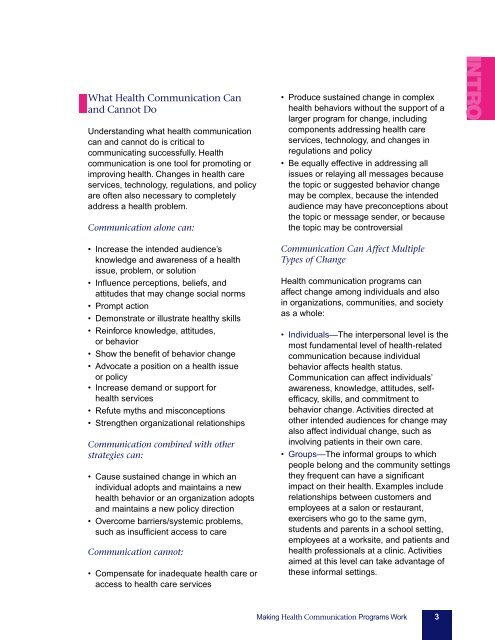pink-book
pink-book
pink-book
You also want an ePaper? Increase the reach of your titles
YUMPU automatically turns print PDFs into web optimized ePapers that Google loves.
What Health Communication Can<br />
and Cannot Do<br />
Understanding what health communication<br />
can and cannot do is critical to<br />
communicating successfully. Health<br />
communication is one tool for promoting or<br />
improving health. Changes in health care<br />
services, technology, regulations, and policy<br />
are often also necessary to completely<br />
address a health problem.<br />
Communication alone can:<br />
• Produce sustained change in complex<br />
health behaviors without the support of a<br />
larger program for change, including<br />
components addressing health care<br />
services, technology, and changes in<br />
regulations and policy<br />
• Be equally effective in addressing all<br />
issues or relaying all messages because<br />
the topic or suggested behavior change<br />
may be complex, because the intended<br />
audience may have preconceptions about<br />
the topic or message sender, or because<br />
the topic may be controversial<br />
INTRO<br />
• Increase the intended audience’s<br />
knowledge and awareness of a health<br />
issue, problem, or solution<br />
• Influence perceptions, beliefs, and<br />
attitudes that may change social norms<br />
• Prompt action<br />
• Demonstrate or illustrate healthy skills<br />
• Reinforce knowledge, attitudes,<br />
or behavior<br />
• Show the benefit of behavior change<br />
• Advocate a position on a health issue<br />
or policy<br />
• Increase demand or support for<br />
health services<br />
• Refute myths and misconceptions<br />
• Strengthen organizational relationships<br />
Communication combined with other<br />
strategies can:<br />
• Cause sustained change in which an<br />
individual adopts and maintains a new<br />
health behavior or an organization adopts<br />
and maintains a new policy direction<br />
• Overcome barriers/systemic problems,<br />
such as insufficient access to care<br />
Communication cannot:<br />
• Compensate for inadequate health care or<br />
access to health care services<br />
Communication Can Affect Multiple<br />
Types of Change<br />
Health communication programs can<br />
affect change among individuals and also<br />
in organizations, communities, and society<br />
as a whole:<br />
• Individuals—The interpersonal level is the<br />
most fundamental level of health-related<br />
communication because individual<br />
behavior affects health status.<br />
Communication can affect individuals’<br />
awareness, knowledge, attitudes, selfefficacy,<br />
skills, and commitment to<br />
behavior change. Activities directed at<br />
other intended audiences for change may<br />
also affect individual change, such as<br />
involving patients in their own care.<br />
• Groups—The informal groups to which<br />
people belong and the community settings<br />
they frequent can have a significant<br />
impact on their health. Examples include<br />
relationships between customers and<br />
employees at a salon or restaurant,<br />
exercisers who go to the same gym,<br />
students and parents in a school setting,<br />
employees at a worksite, and patients and<br />
health professionals at a clinic. Activities<br />
aimed at this level can take advantage of<br />
these informal settings.<br />
Making Health Communication Programs Work 3


